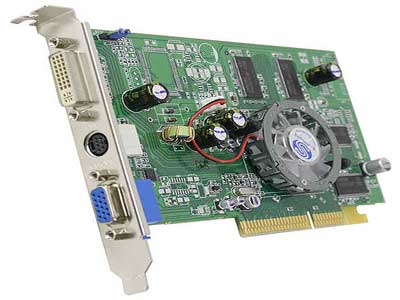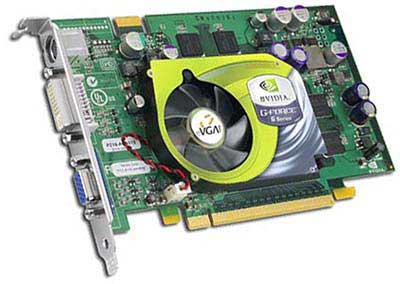Buyer's Guide - Mid-Range, October 2004
by Jarred Walton on October 21, 2004 11:00 AM EST- Posted in
- Guides
Graphics Recommendations
The only typical applications that actually require a decent graphics card are games, but depending on how you plan to use the system, adding a little more power to the graphics subsystem may not be a bad idea. We listed an integrated graphics motherboard as an option for a base Intel system, and that will save you a little money. For the AGP models, a basic Radeon or GeForce will get you by. One of the advantages of purchasing an add-in card is that even the basic models support two displays. This is definitely an advantage for software development and content creation work, where having dozens of windows open at a time is par for the course.Those who are interested in more serious work, like 3D modeling and rendering, might want to look into professional 3D graphics cards, although moderate consumer graphics cards will be sufficient for less serious work. Those looking for an all-around system will also want more than just a basic graphics card. With that said, let's get on to the recommendations.

AGP Recommendation: Sapphire Radeon 9600 Pro 128MB
Price: $108 Shipped (OEM)
At just over $100, the 9600 Pro offers tremendous value. Casual gamers will have more than enough performance for most games, while those interested in content creation or software development get the proven reliability and performance of ATI's drivers. TV Out is also included, for those who might be looking for a Home Theater PC. While it might seem like overkill for anyone who doesn't use any form of 3D graphics, it is hard to recommend anything less than a DirectX 9.0 capable graphics card for any system costing over $1000. Remember that Windows Longhorn - assuming it ships anytime soon - is going to require DX9 support as the bare minimum in order to run. The one option that isn't available for this price is dual DVI output, so those looking at running dual LCD displays might want to find a model that has two DVI ports. While the performance is lower, HIS makes a dual DVI 9600 card that might interest some of you. Downgrading to a stock 9600 or even a 9600SE is also an option if you are sure you don't need the added performance of the 9600 Pro.

Basic PCIe Recommendation: Sapphire Radeon X300 128MB
Price: $85 Shipped (OEM)
PCI Express graphics cards tend to carry a slight price premium, and the X300 is actually comparable to the 9600. The X600 Pro matches the clock speeds of the 9600 Pro, but it costs a little more. For basic computing tasks other than gaming, they will both perform acceptably, so here we go with the slightly cheaper X300. Unfortunately - or fortunately if you're looking for an excuse to upgrade - those looking for dual DVI ports will need to buy a 6600GT card for the time being; specifically, the XFX is one card that includes that option. There are no other PCI Express graphics cards with two DVI ports other than the ultra-expensive X800 XT and Quadro FX1300, which really aren't an option for this price range.

PCIe Alternative: eVGA 6600GT 128MB
Price: $207 Shipped (Retail)
Here, PCI Express has a slight advantage in the price/performance category. The 6600GT includes 8 pixel pipelines, and with a core clock of 500 MHz, it outperforms any AGP card in the same price bracket. ATI's X700 Pro is also available at about the same price and it is similar in features, but comes with 256 MB of GDDR3. The X700XT with 128 MB of RAM and faster clock speeds is also due to show up in retail any time now, but we have not been able to find it there yet. This is really a gaming option, but we would feel remiss if we didn't at least mention it, as the 6600GT is one of the best price/performance graphics cards currently available.
For AGP systems that will be used for moderate amounts of gaming, the only comparable card right now is the 9800 Pro. It's a bit slower in most games and lacks support for SM3.0 but it performs acceptably. The GeForce 6800 is also an option that is slightly faster than the 6600GT and costs a bit more.










54 Comments
View All Comments
PrinceGaz - Thursday, October 21, 2004 - link
pg.3 under AMD CPU Alternative: "The 3400+ is also an option for additional performance and at 2.4 GHz, it is only slightly slower than the 3800+ at roughly half the cost. Our past tests have shown that the additional 512K of L2 cache does not usually boost performance of the Athlon 64 processors as much as an additional 200 MHz of clock speed will, so we recommend the Newcastle cores over the Clawhammer variants"It should be 3700+ rather than 3800+ as we are talking about S754 processors.
HVAC - Thursday, October 21, 2004 - link
I think you should revise the comments on the price of the hard drives to reflect 58 and 59 cents per GIGAbyte, not per MEGAbyte.JClimbs - Thursday, October 21, 2004 - link
Good article, I like seeing multiple choices and reading the +'s and -'s for each.Tides - Thursday, October 21, 2004 - link
you mention ocz for 220 bucks but a gig of pqi @ 2-2-2-5 (TCCP samsung chips) goes for 30more which as we've seen in your own reviews does awesome.